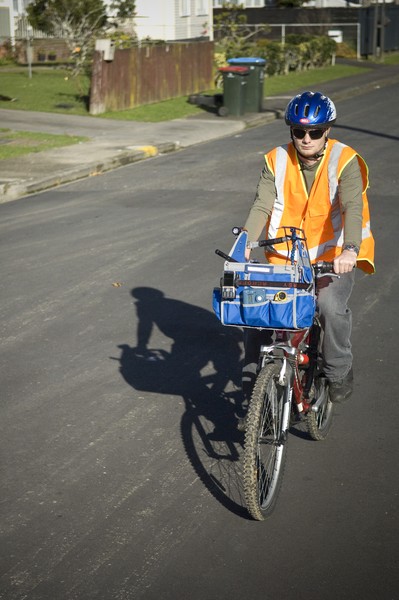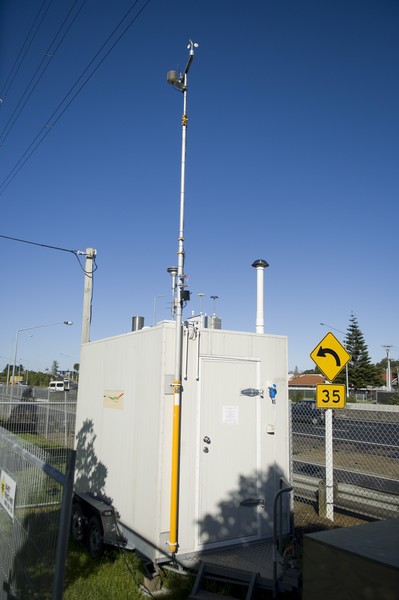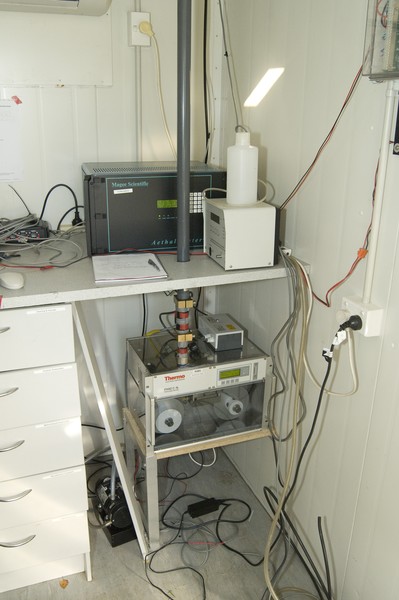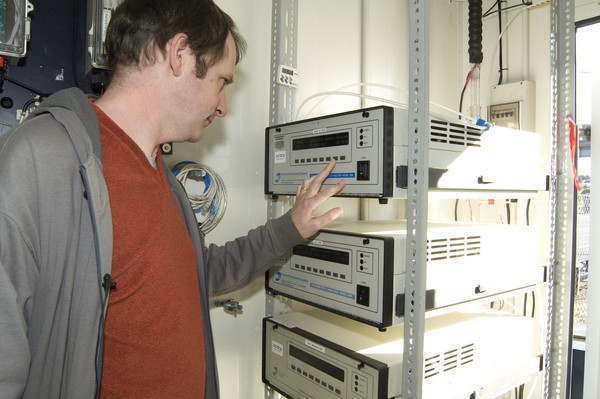NIWA launches biggest-ever scientific air quality campaign
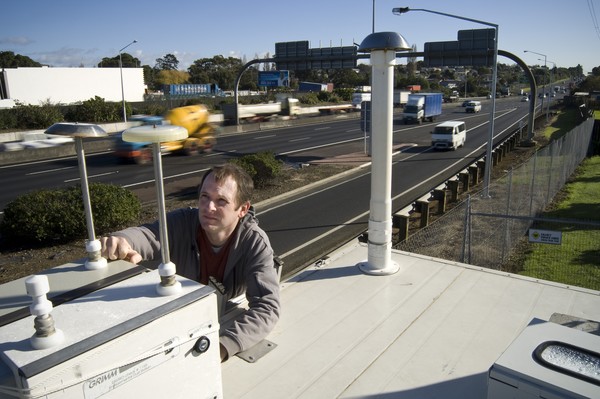
NIWA is looking at the long-term effects of motorways and wood smoke on air quality. Scientists are assessing the impacts of Auckland’s southern motorway on air quality in a surrounding neighbourhood. They are doing this to understand more about the health effects of air pollution.
NIWA scientists, along with Kim Dirks from Auckland University and Simon Kingham from Canterbury University, are gathering a picture of the long-term and seasonal variations of concentrations of air pollutants. They have analysed emissions from the motorway, their dispersion downwind, and the penetration of outdoor air into the indoor environment. Emissions from other sources (local roads and domestic woodburning) were monitored upwind of the motorway.
http://www.youtube.com/watch?v=78XD0jkAFPo
The scientists gathered their outdoor air-quality data by:
• car
• bike
• lampposts (sampling tubes on lampposts)
• air quality monitoring stations.
NIWA designed and mounted a mobile air-quality system in a late model Ford Falcon. A quarter-century-old bike had a basket on the front containing measuring equipment. Sampling tubes were positioned on lampposts, and three air-quality monitoring stations were strategically positioned within the one square kilometre study area.
“We chose a 1 kilometre radius site in Otahuhu. It’s a flat neighbourhood which allows us to concentrate on the effects of dispersion, and it’s a very typical New Zealand layout, with small sections and low density houses – it means that we can apply our results to other locations across New Zealand,” says NIWA air quality scientist, Dr Ian Longley.
Woody Pattinson, a Canterbury University PhD student, became part of this living, breathing reality, experiment as he rented a house in the area and monitored the outdoor and indoor air quality of his surroundings.
One of the aims of this work is to find out how we might reduce the number of people exposed to health-endangering concentrations of air pollution close to motorways. International research shows that the impact of major roads is significant up to one or two hundred metres distance and possibly further.
In New Zealand, there is a risk that National Environmental Standards for air quality (and World Health Organisation WHO guidelines) might be breached alongside major roads.
“These findings will help clarify and identify locations where the impacts of transport emissions are significant,” says Dr Longley.
Poor air quality can have very serious long-term health effects for those with pre-existing respiratory conditions, e.g., chronic bronchitis, asthma, and cardiovascular conditions.
The scientists are also investigating the significance of wood smoke in the area to compare its impact with emissions from traffic.
http://www.youtube.com/watch?v=q6BOedljwFo
Background
How NIWA scientists investigate outdoor air quality
1. Using outdoor air-quality monitoring stations
Three trailer-based air-quality monitoring stations were strategically positioned within the one square kilometre study area.
The air-quality monitoring stations use four instruments to measure multiple pollutants. The main roadside contaminants that impact on health are:
• carbon monoxide, which is largely emitted from petrol cars;
• nitric oxide and nitrogen dioxide emitted from diesel vehicles;
• particulate matter (the small flecks of soot, fumes and dust that come from traffic and wood smoke).
“One air-quality monitoring station was positioned right next to the motorway, one 100 metres downwind of the southern motorway, and one on the upwind side,” says Dr Longley. Using three stations allows the scientists to fully model the influence of the motorway and weather patterns on air quality, and to distinguish this from other sources of contaminants such as traffic elsewhere in Auckland, and from wood heating.
Most of the instruments recorded their highest measurements in the morning rush hour, especially when there was little wind. However, levels of particles were as high or higher on winter evenings when there were more people burning wood to heat their homes.
2. The monitoring bike
During the measurement phase, Woody was following a rigorous daily schedule. He started his day in the house rented for the study by making sure all the instruments are running. Then, using a bike his grandfather gave him, he conducted up to three trips a day around a grid-like area, travelling at different distances from the motorway. This allowed the instruments on his bike to gather data on the levels of pollutants from the motorway. Woody even did a late bike run each night, gathering readings of smoke from wood fires.
Woody’s quarter century old bike had a basket on the front containing his measuring equipment. The cellphone in the basket logged the GPS coordinates to record where he had been, took a photo every three seconds and recorded voice logs of what he saw as he travelled. A dust monitor logged background concentrations of wood smoke, and a condensation-particle counter logged ultra-fine particles representative of fresh vehicle emissions, especially diesels.
The basket also contained a weather-tracking instrument that recorded temperature and humidity, and a carbon monoxide sensor.
3. Sampling tubes
While Woody was out on his bike he checked the 30 sampling tubes. These little glass flasks with filters in them were discreetly positioned on lampposts, a couple of meters off the ground, at different distances from the motorway. They gathered information that is being used to analyse the different pollutant levels away from the motorway, specifically nitrogen dioxide. Woody changed the tubes every two weeks.
4. Air quality system in a late model Ford Falcon
NIWA designed and mounted a mobile air quality system in a late-model Ford Falcon. On one side of the car there was a false window that allowed outside air to be drawn through a tube and into the car. Inside the car were two instruments: an aethomemeter and a particle counter. These instruments measured black carbon and gave a time-series chart of the particles, updated second-by-second, as they entered the instruments.
“We were trying to map air quality, street-by-street, almost metre-by-metre. So second-by-second we can see how air quality varies across our study area. The logging system was designed, created, and built entirely by NIWA staff,” says Dr Longley.
The system is sensitive enough to record the response of individual vehicles.
Methods used to investigate indoor exposure
Back inside the house, Woody became part of the experiment as he lived there for several months, overseeing the recording instruments.
The house, like a lot of New Zealand houses, was relatively draughty and not well insulated. The indoor instruments measured the same contaminants as the outdoor air-quality monitoring stations.
Most people spend most of their time indoors, especially at night and when there is wood smoke in the area.
“The choice of three-month research period, from April to June 2010, was deliberate,” says Dr Longley. “It’s the start of the wood-burning season in winter. The scientists investigated indoor air quality and the indoor exposure of local residents to car emissions, and to wood smoke. In the early stages of the experiment we were confident that most of the contaminants were due to the motorway and the traffic. As the experiment progressed we could see more and more people lighting fires, so we could contrast the difference that had on air quality.”
The indoor instruments gathered data every minute and at the end of every week this ‘indoor’ data was sent back to the office at NIWA in Auckland. The data could then be compared with data from outside the house.
Using the results
The experiment was designed to allow quantification of pollution levels around existing road infrastructure and to plan and estimate for future scenarios. The data gathered will be used within this project to evaluate and improve on the air quality models which are currently used in planning major new roads, such as the Waterview Connection. The NIWA team are also planning follow-up studies with public health researchers to apply the findings across the country to find out how the risk from living near traffic compares to other public health risks, such as damp homes and smoking.
The experiment was also designed to assist a separate study (called TOTUS) looking at how the design of a neighbourhood (its street layout and land-use) determines its emissions and exposures. This will lead to modelling tools for New Zealand’s urban planners and managers that incorporate and integrate different environmental, health, and energy-related parameters into the urban development decision-making process.
The campaign is supported by three projects. NZTA are funding the main motorway study and full results will be reported early in 2012. This is a collaborative project led by NIWA, partnered by the Universities of Canterbury and Auckland.
FRST (The Foundation for Research Science and Technology) are funding the wood smoke and indoor parts of the study (Healthy Urban Atmospheres programme), and the focus on urban form (the TOTUS project). These results will be released in 2012. These studies are led by NIWA, supported by the University of Canterbury and Landcare Research.
WHO Health impacts and New Zealand standards
Air pollution is a major environmental risk to health and is estimated to cause approximately two million premature deaths worldwide per year.
By reducing particulate matter (PM10) pollution from 70 to 20 micrograms per cubic metre, we can cut air-quality related deaths by around 15%. Material from: http://www.who.int/topics/air_pollution/en/
An Auckland Regional Council study in 2007 showed 400 people die prematurely each year because of health effects related to air pollution, much of which came from diesel.
Poor air quality is responsible for more than 750 000 ‘restricted activity days’ every year. Air pollution has the greatest affect on the young and the elderly, and people with heart disease, respiratory disease, asthma and bronchitis. The associated costs for the Auckland Region are estimated to be in excess of NZ$1.3 billion per year.
Material from: http://www.arc.govt.nz/albany/fms/main/Documents/Environment/Pollution/airfacts5.pdf

